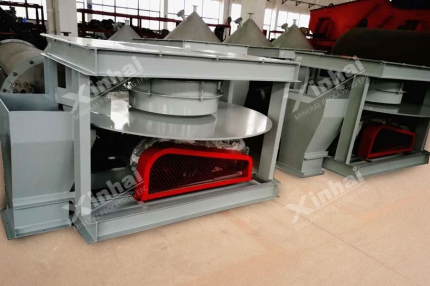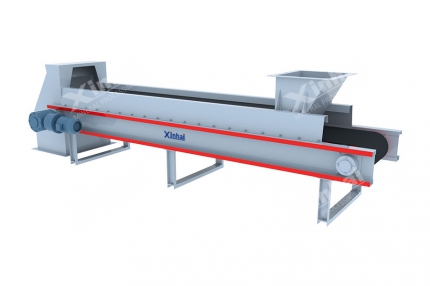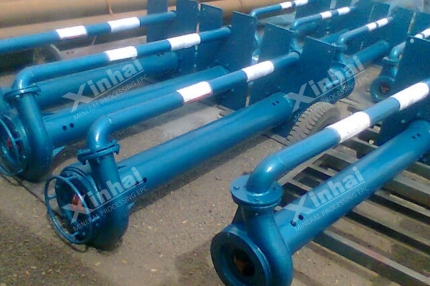According to the movement mode of the material during the leaching process, the chemical leaching process can be divided into the percolation leaching process and agitation leaching process. The percolation leaching process is a common mineral processing method used in the treatment of abandoned pillar, surrounding rock, tailings and low-grade minerals.
The percolation leaching process is a kind of leaching method in which the leaching agent penetrates the fixed ore bed in a top-down or horizontal manner by means of gravity or pressure. It is the key to ensuring the economic benefit of the concentrator to choose the appropriate percolation leaching way. Next, we will introduce you to the percolation leaching process from the selection of percolation leaching way and leaching agents.
Use the table of contents below to navigate through the guide:
01One. Selection of percolation leaching way
1. According to the different mine and ore property
The different mines mean different percolation leaching ways, which mainly include tank leaching (pool leaching), heap leaching and in-situ leaching. In general, the tank leaching way can be used in the lean ore with low porosity, and the ore must be crushed to less than 10 mm in the tank leaching way. The heap leaching is often used in the ore that is extracted or crushed to a certain size, such as the waste rock with high porosity, surface ore and lean ore. The in-situ leaching way is mostly used for recovery of target minerals in underground mines extracted by the block caving method or residual ore, jamb in goaf.
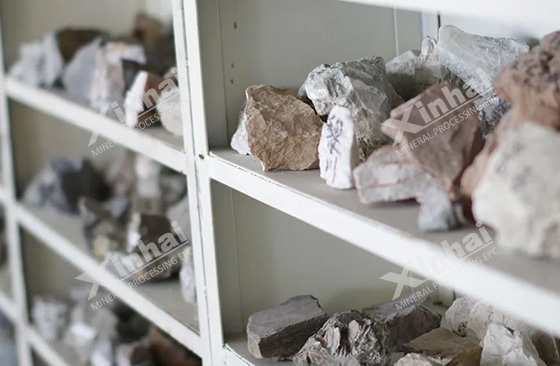
(1) Tank Leaching Process:
The shell of the leaching tank can be made of different materials according to the size of the production and processing capacity. The size of the leaching tank depends on the scale of production design. In the actual production, the multiple leachate tanks can be used simultaneously. In general, a false bottom shall be set at 0.1-0.2m of the bottom of the percolation leaching tank, and the permeable materials are laid on the false bottom, and then a thick layer of block ore shall be laid on it. At the same time, in order to facilitate the flow of the leaching liquid in the tank, the bottom can be slightly inclined to the outlet direction of the leaching liquid. The lining of the leaching tank shall be made of different materials according to the treatment of different ores and the use of leaching solution (various acids, bases and other leaching agents), such as asphalt, acid-resistant concrete, lead plate, epoxy resin, polyethylene plastic and polymeric materials.
(2) Heap Leaching Process:
Taking the gold mine as the example, the heap leaching process is to mix the sticky ore grain with protective alkali (lime), and pile up on the leak-free ground (leaching pad), the cyanide or eco-friendly gold leaching is aspersed on ore heap. When the solution permeates the ore heap from top to bottom slowly, the gold is dissolved, and the gold solution (expensive liquid) flows from the bottom is sent to the charcoal adsorption-desorption electrolysis or dust replacement process so as to obtain the gold mud. The precious metal is obtained after the refining, and the gold cyanide solution or non-toxic gold leaching solution (barren solution) returns to recycling.
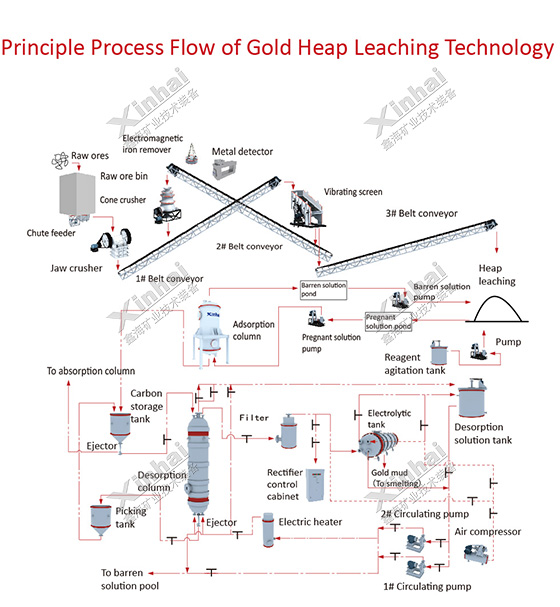
(3) In-situ Leaching Process:
The in-situ leaching process means to drill a hole in the ground area of a good stope, then inject the leaching agent into the ore body through the injection hole, and the leaching solution is pumped to the ground through the recovery hole for treatment. Using the in-situ leaching process can reduce the expensive investment cost in good construction, mining, transportation, grinding and other processes. At the same time, it can also reduce the environmental pollution. However, the ore body must have good permeability, and there are the corresponding impermeable layers and stable bedrock around the ore body. The groundwater level shall be lower, which can prevent the leaching liquid from flowing out and is conducive to the recovery of the leaching liquid. At present, the in-situ leaching process is mainly used to recover the copper, uranium and rare earth from the goaf with the clean water, acidic liquid and inorganic salt as the leaching agents.
2. According to the relative motion of the leached material and the leaching agent
According to the relative movement of the leached material and the leaching agent, we can select the fair current, counter current and cross-flow leaching ways. The fair current leaching way can be used if the movement direction of the leached material and the leaching agent is the same. On the contrary, the counter-current leaching way can be used. The cross-flow leaching way can be used when the flow direction of the leached material and the leaching agent is staggered. The percolation leaching tank can adopt the above three kinds of leaching way, while the heap leaching process and in-situ leaching process generally adopt fair current leaching way.
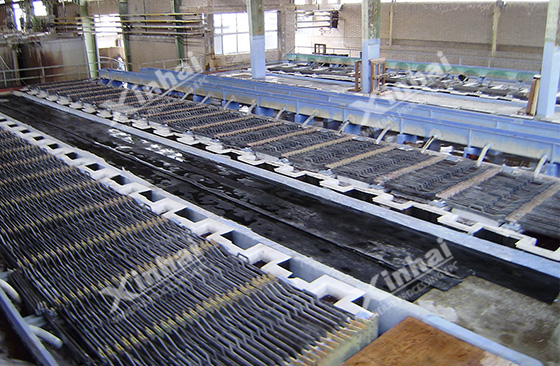
(1) Fair current leaching:
The fair current leaching is also called parallel leaching. The content of the target components in the fair current leaching solution is higher and the consumption of the leaching agent is lower. However, the leaching speed is low and the leaching time is long. In the production, the concurrent flow continuous leaching way can be adopted, in which the movement direction of concentrate and leaching agent is the same. The concurrent flow continuous leaching is to add the leaching agent, water and concentrate continuously to the reactor and the material is continuously discharged, which has the advantages of large equipment production capacity, high heat utilization rate and low energy consumption.
(2) Counter current Leaching:
The counter-current leaching can make full use of the remaining leaching agents in the leaching liquid, which can obtain and the leaching liquid with a higher content of the target components effectively. The countercurrent leaching can make full use of the remaining leaching agent in the leaching liquid, so the consumption of the leaching agent is relatively low. But this kind of leaching process has the high operation control request, mostly applies to the low-grade concentrate leaching.
(3) Cross-flow Leaching:
The leaching speed of cross-flow leaching is fast, the leaching time is short, and the leaching rate is high. However, due to the large volume of the leaching liquid, the concentration of the remaining leaching agent in the leaching liquid is higher, so a large amount of leaching agent needs to be consumed. The content of the target components in the cross-flow leaching solution was lower. At present, the cross-flow leaching way is mainly used for low-grade metals with high value.
02Selection of leaching agent
The leaching agents are the reagents used for the leaching process, including aqueous solution and non-aqueous solution. The leaching method is different, so the choice of the aqueous solution is not the same. The common leaching processes include alkali leaching process, acid leaching process, salt leaching process, bacterial leaching process and water leaching process.
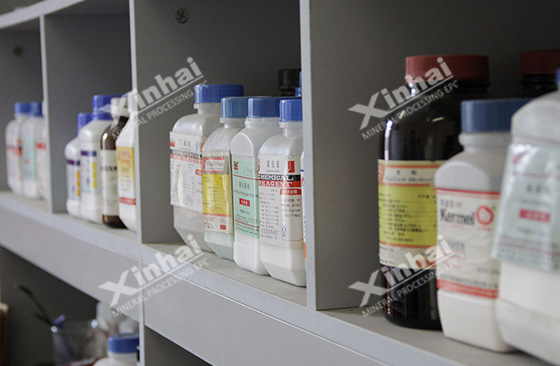
(1) Alkaline leaching process:
It often adopts the sodium carbonate, caustic soda, ammonia water, sodium sulfide. It is suitable for removing the silicate impurities in non-saline minerals, such as graphite and diamond.
(2) Acid leaching process:
It is common to remove pigmented impurities (the various compounds containing iron, such as Fe2O3) from non-metallic minerals before they are used for special industrial purposes. The acid leaching process is an effective method to remove the thin film iron from non-metallic minerals. The common leaching agents used in the acid leaching process are dilute sulfuric acid, concentrated sulfuric acid, hydrochloric acid, nitric acid and aqua regia, which can be used for gold, silver, copper, phosphorus, molybdenite and so on.
(3) Salt leaching process:
The salt leaching process takes the aqueous solution of an inorganic salt or its acid (or lye) as the leaching agent. The commonly used leaching agents are sodium chloride, ferric chloride, copper chloride, sodium cyanide, which can be used to treat white lead ore, lead oxide mineral, copper, lead, the bismuth sulfide ore and so on.
(4) Bacterial leaching process:
The bacterial leaching process often adopts the species, sulfuric acid and ferrous sulfate as the leaching agent, which can be used to deal with copper, uranium, gold sulfide ore.
(5) Water leaching process:
The water is used as a common leaching agent in the water leaching process, which is mainly used for the treatment of bile alum ore and calcined sand.
In the actual production, it is very important to choose the appropriate percolation leaching process and leaching agent. The different mines mean different applicable percolation leaching processes. Therefore, it is suggested that the mine owner should choose the manufacturer who can conduct the mineral processing test, conduct the mineral processing test first, and then choose the appropriate percolation leaching process, thus avoiding the unnecessary economic losses.


 marketing@ytxinhai.com
marketing@ytxinhai.com  0086 13810327080
0086 13810327080 






































































































 CHAT
CHAT MESSAGE
MESSAGE



